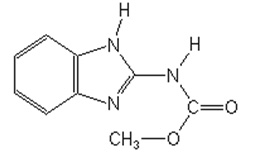|
|
Chemical identity
Technical sheet
Application
Chemical name:Carbendazim
Use category:Fungicide
Content & formulation:Carbendazim 98% TC
Carbendazim 50% WP
Carbendazim 50% SC
Structure Formula:

Common Name:Carbendazim (BSI, E-ISO); carbendazime ((f) F-ISO); carbendazol (JMAF)
CAS No.:10605-21-7
CAS Name:Methyl 1H-benzimidazol-2-ylcarbamate
Molecular Formula:C9H9N3O2
Agrochemical Type:Fungicide, benzimidazole
Mode of Action:Systemic fungicide with protective and curative action. Absorbed through the roots and green tissues, with translocation acropetally. Acts by inhibiting development of the germ tubes, the formation of appressoria, and the growth of mycelia.
|
Specification for Carbendazim 98% TC
|
|
ITEMS
|
STANDARDS
|
|
Appearance
|
White to light brownpowders
|
|
Content of a.i.
|
≥98 %
|
|
Loss on drying
|
≤1.0%
|
|
Specification for Carbendazim 50% WP
|
|
ITEMS
|
STANDARDS
|
|
Appearance
|
White powder
|
|
Content of a.i.
|
≥50.0%
|
|
Fineness (pass 325 mesh)
|
≥96.0%
|
|
Suspensibility
|
≥80.0%
|
|
pH Value
|
5.0-8.5
|
|
Wetting time
|
≤90s
|
|
Specification for Carbendazim 50% SC
|
|
ITEMS
|
STANDARDS
|
|
Appearance
|
Flowable suspension liquid
|
|
Content of a.i.
|
≥50%
|
|
Suspensibility
|
≥90%
|
|
Fineness (through 75μm sieve)
|
≥98%
|
|
pH Value
|
5~8
|
Packing: According to client’s requirement.
Application:Control of Septoria, Fusarium, Erysiphe and Pseudocercosporella in cereals; Sclerotinia, Alternaria and Cylindrosporium in oilseed rape; Cercospora and Erysiphe in sugar beet; Uncinula and Botrytis in grapes; Cladosporium and Botrytis in tomatoes; Venturia and Podosphaera in pome fruit and Monilia and Sclerotinia in stone fruit. Application rates vary from 120-600 g/ha, depending on crop. A seed treatment (0.6-0.8 g/kg) will control Tilletia, Ustilago, Fusarium and Septoria in cereals, and Rhizoctonia in cotton. Also shows activity against storage diseases of fruit as a dip (0.3-0.5 g/l).
|
|
|
